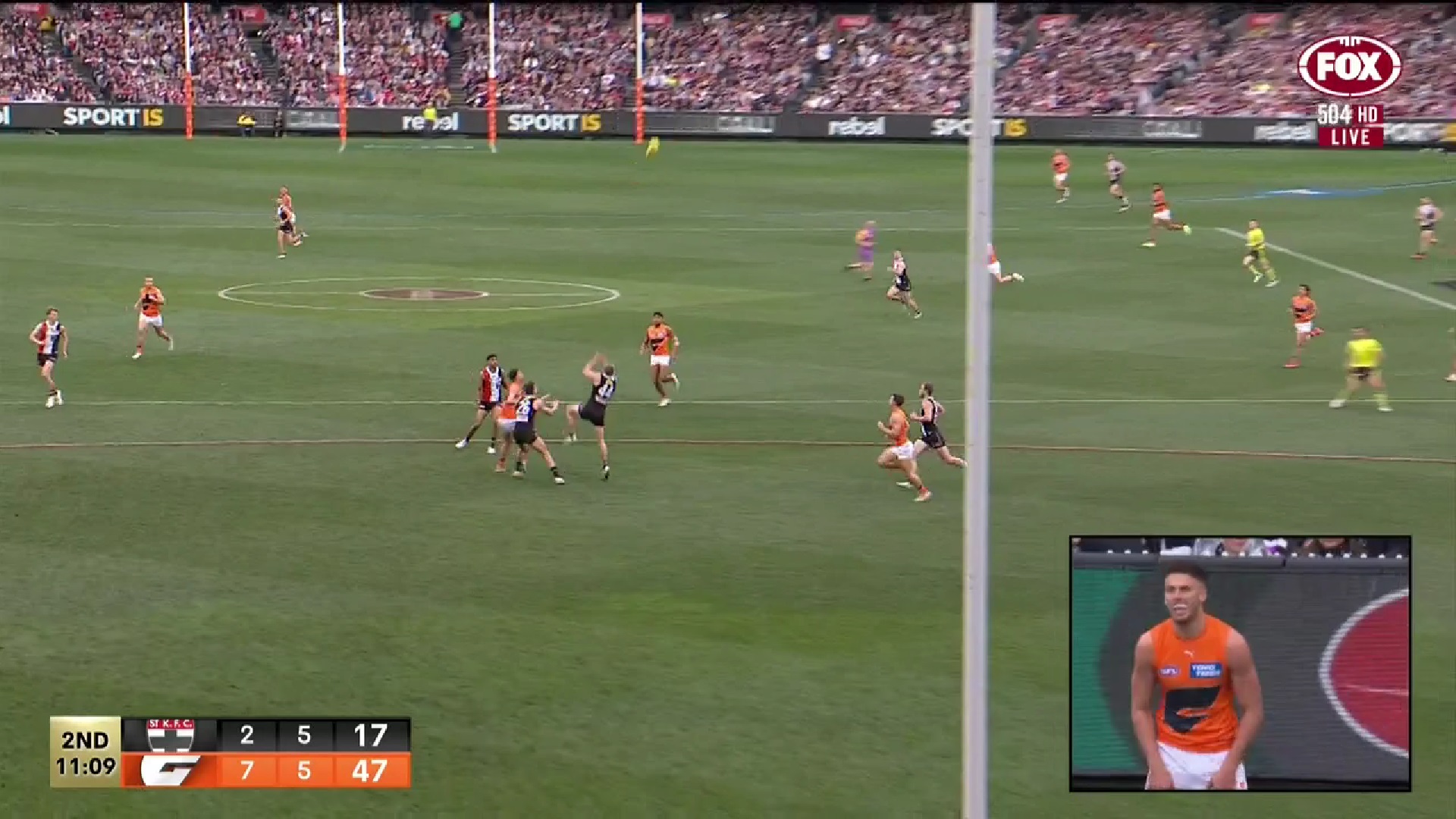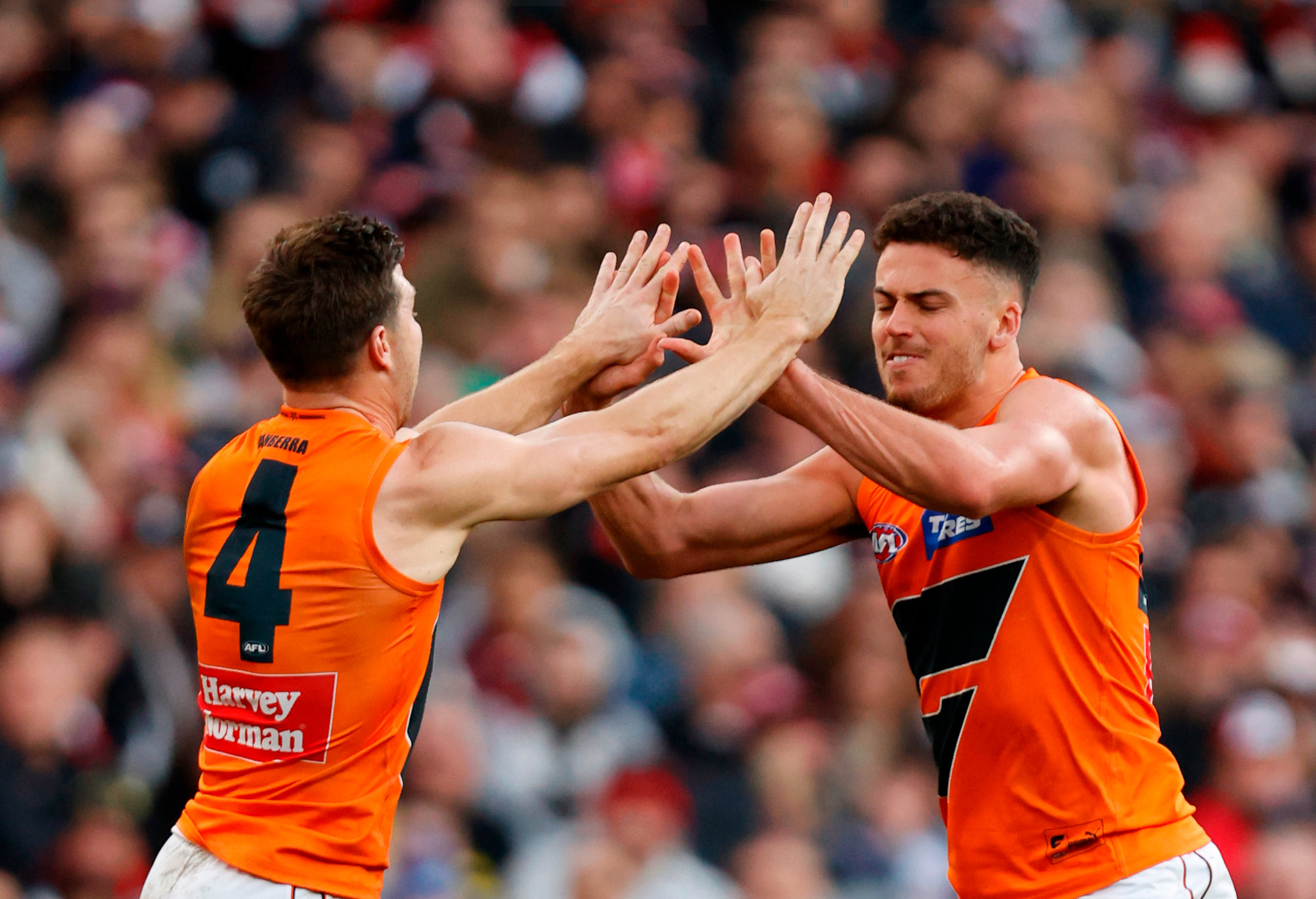If you’re a team that prides itself on being the stingiest, most miserly defence in the competition, and then you go and concede a triple-figure score in a big final, chances are you’re going to lose the game.
For just the second time this year, St Kilda gave up the ton, and with it any chance of taking down GWS in their elimination final, or making good on their own score of 70 that, often enough this year, has been a winning total for them.
That this was a shootout in the end, or as close to a shootout as modern footy, particularly finals footy, usually allows, will have infuriated Ross Lyon, as much for the fact that after spotting the Giants a 43-point lead midway through the second quarter he was obligated to fight fire with fire and instruct his charges to take more aggressive options to try and wrestle their way back into the game.
It worked – twice; the Saints responded to twin seven-goal leads by the Giants, a quarter apart, by banging on a flood of goals in rapid succession to threaten the most Herculean of comebacks.
But time and again, their defence – their greatest asset this season, and indeed in Lyon’s first iteration as coach a decade plus ago – let them down, constantly allowing the Giants the steadying goals they required to never truly be threatened, as much as the din from a sizeable Saints contingent at the MCG would have had their boys believe.
That the most miserly, by virtue of points conceded, backline in footy this year, one designed by Lyon to restrict scoring more than any other team in the game, failed so devastatingly against a Giants’ forward line that aren’t exactly a murderer’s row of stars demands closer inspection.
And to my eyes, it was down to two vital decisions made by Lyon, one on match day and one in the days leading up to the sudden-death final. Neither worked, and both served to destabilise a usually watertight defensive unit enough to give the Giants the regular openings they needed.
Let’s start with the former first: the decision to give Callum Wilkie, the reigning All-Australian full back and the Saints’ best defender, the big job on Toby Greene.
On paper, it makes sense: Greene is such a colossus when on song, and so crucial to every Giants’ surge in the second half of the season, that putting your number one backman to guard him for much of the afternoon is perfectly logical. Indeed, just a single goal from Greene is a result the Saints would have taken to the bank if it had been offered pre-game.
The issue is that, while Greene is clearly the Giants’ most dangerous forward, he isn’t their only one. And just as crucially, his movements are unlike that of the traditional gun forwards of the game, the ones Wilkie has made a living out of stopping for four years.
There was a great example during the second quarter, in the vision below:

Beginning with a stoppage on the wing, Wilkie is guarding Greene as he should be: back shoulder, confident in his closing speed to spoil or at least force the Giants skipper up the ground to get a kick.
But when the ball comes long and more centrally, towards the contest between Jake Riccardi and Josh Battle, Wilkie’s instincts as the Saints’ interceptor in chief – he leads the club for intercept marks this year and is second behind Dougal Howard, who didn’t play, for spoils – takes it upon himself to get over and support his mate.
Ostensibly, this means Jimmy Webster, the loose man behind the ball at the last stoppage (another job often occupied by Wilkie), gets the responsibility on Greene: indeed, I wonder if that was the plan laid out by Lyon pre-match.
Wilkie’s problem is that he’s too late to arrive to either mark or force the ball clear: and the minute that ball hits the ground, Greene is in his element. And worse still, the Saint has inadvertently laid a perfect block on Battle to give Riccardi a second of free space.
It’s enough: Greene wins the ball, shrugs the Webster tackle, gives to Riccardi, and the number 26 snaps through a goal to extend the Giants’ lead to an even five goals.
Defensive lapses like this happened with frequency throughout the afternoon: take this example in the third quarter, with the Giants once again bursting out to a 43-point lead.
Ordinarily, Wilkie would pay little mind to his opponent, fly for the ball and either try to mark it or spoil away from danger – he’s done it all season, and it’s a big reason why the Saints made it to September in the first place.
But you’ll see, as the ball comes down, Wilkie’s first instinct is to engage with Greene, jostling with him for the space under the ball. And the second he locks up with him, Toby senses an opportunity, as great readers of the game do.
Greene’s focus moves in a split second from marking the ball to denying Wilkie a run at it: putting his body in the path of the Saint, he allows it to hit the ground. Because he knows the closest Giant is the zippy Brent Daniels.
Burning away from Nasiah Wanganeen-Milera – helped by a Greene block – Daniels gathers the spilled ball, handballs over the top of a leaping Webster, who has left Toby Bedford free to try and shut it down. Gathering the handball, it’s Bedford who finishes the job.
Wilkie is the game’s best interceptor, averaging more than eight a game this season and accumulating more intercept possessions than anyone in the league. He’d only manage four, his lowest since Round 6 and second-fewest for the year – two of them powerful grabs on the wing and well away from defence in the second quarter – which was as big a win for the Giants as Greene’s solitary goal was for the Saints.
The big stat of the day was the Giants scoring 54 points – eight goals and six behinds – from stoppages, despite having just one more clearance than the Saints. My view, though, is that the reason for it came not from the way the Saints were positioning themselves around the ball, but that every time the Giants broke away from a contest and kicked it long, the defence was vulnerable with Wilkie, its lynchpin, trying to nullify a forward smart enough to make an impact even without getting the footy in his hands.
Wilkie will surely head to bed tonight with a stiff neck from watching the ball sail over his head time and time again as it entered the Giants’ forward 50, with Greene drawing him up the ground and away from the dangerous space he normally dominates.
I wonder if the Saints star was spooked enough by this early goal, when he made the right decision to come off Greene and attack a loose ball but got unlucky with a deflection and conceded to his man, to pay Greene undivided attention for the most part of the rest of the afternoon. Too much attention, as it turned out.
The Saints this year have conceded a score, on average, every 2.48 inside 50s they concede. On that basis, the Giants should have won themselves 21 or 22 scoring shots – exactly what the Saints themselves mustered.
The Giants had 26 – enough, with some mostly excellent kicking for goal, to not just win, but score 101 points. That doesn’t happen for no reason, and Wilkie’s unusual role, and Greene’s genius to be able to exploit it, was vital to that breakdown.
The second reason came in pre-match, with the decision to not select Dougal Howard and give key defender responsibilities to Zaine Cordy.
Wilkie’s role comes into play here, to: usually, he’d have been the one to take Jesse Hogan, the Giants’ forward lynchpin, which would have given Cordy the role on Riccardi and left Battle, the Saints’ second-best interceptor behind Wilkie, the chance to zone off third tall Lachie Keeffe.
But Howard’s omission, as the Saints’ best spoiler – and, importantly, with a height of 199 centimetres and an even bigger wingspan, his gigantic size – made a difference, and as difficult as it would have been to play the much-maligned defender over Cordy having missed a month with a fractured wrist, it was also probably the right one to make.
Cordy’s problem, as it was at the Western Bulldogs for years, is that he has consistently been among the worst one-on-one key defenders in the competition. This year, he’s lost five of 14 contested one-on-ones in the Saints’ defensive half, at a loss rate of 35.7 per cent – of regular key backs, only Rhett Bazzo and Trent McKenzie have fared worse this year.
Battle, too, was outclassed by the underrated Riccardi, who kicked three goals and should have had four but for an awful miss from close range in the last quarter. With great hands and a surprising turn of pace for a player of his size, Riccardi is the perfect foil to Hogan’s brute strength, and whenever Wilkie was occupied further up the ground, there was danger.
Contrast that to the Giants’ defensive 50, which centres on their own lynchpin in Sam Taylor. His contest with Max King was a fascinating one, and in the end honours were probably matched or even won by the Saint with two crucial second-quarter goals: but the difference was that King was far less mobile than Greene, and the Saints’ entries towards him more predictable.
King, for the most part, stays inside 50, a commanding presence but one that doesn’t roam like Greene does. It’s possible to use him as a reference point to then move off if helping others is needed, which Taylor did throughout proceedings. And with fewer other attacking options with Tim Membrey a late out, the likes of Connor Idun and Jack Buckley were far more capable of handling Anthony Caminiti and Cooper Sharman – though the latter started superbly – than at the other end.
Riccardi ended with four marks inside 50, and by the last term he was comprehensively outplaying Battle. Hogan, too, had three, and while Sharman and King mustered three apiece up the other end, it was the Giants who looked much more dangerous in attack.

Jake Riccardi celebrates a goal. (Photo by Darrian Traynor/AFL Photos/via Getty Images)
If the plan was for Wilkie to essentially play as a small or mid-sized defender and take responsibility for Greene, then there was room to play Howard as one of four talls without being too top-heavy. Alternatively, he could have slid in for Cordy, who just wasn’t powerful enough to match a behemoth like Hogan, who plucked a team-high three contested marks.
The Saints’ defence is a more complex system than it appears, and while it has been this year’s best, it failed them when it mattered most.
It just goes to show how fragile any footy team is: even the slightest changes to the status quo, like ripples on a pond, can have a devastating effect.
With Howard not picked, and Wilkie nullified, the Saints just found that out the hard way.






























































































